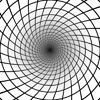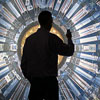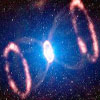Five Dimensional Black Holes Could Break Laws of Physics
 This still from a computer simulation depicts the shape of a theorized five-dimensional black hole, which appears as a ring instead of a sphere. In the simulation, the black-hole ring starts off smooth, but then gives rise to a series of strange bulges. Credit: Pau Figueras, Markus Kunesch, and Saran Tunyasuvunakool
This still from a computer simulation depicts the shape of a theorized five-dimensional black hole, which appears as a ring instead of a sphere. In the simulation, the black-hole ring starts off smooth, but then gives rise to a series of strange bulges. Credit: Pau Figueras, Markus Kunesch, and Saran TunyasuvunakoolBlack holes are messy in four dimensions. But add a fifth, and a black hole could shatter the laws of physics, scientists have shown.
Researchers from the University of Cambridge in England and Queen Mary University of London have successfully simulated a black hole in five dimensions with a supercomputer. Instead of having a spherical shape, such a black hole resembles a very thin ring, which gives rise to a series of bulges. At first these bulges are connected via puny strings, but as time wears on those strings become thinner, until the bulges break off into their own mini black holes.
So what’s the problem?
Well, in a four-dimensional universe, the singularity — the point in the black hole’s center where gravity is so intense that general relativity breaks down — remains hidden behind the event horizon. But in a five-dimensional universe, once that black string breaks into a series of mini black holes, the singularity is visible to the outside world. In theory, an observer could see physics break down before his or her own eyes, a thought that makes any scientist cringe. [The Strangest Black Holes in the Universe]
The key is that general relativity underpins everything scientists know about gravity. It’s an essential tool when it comes to estimating the age of the universe and even calculating GPS signals. In the 100 years since Einstein first laid out the theory, relativity has passed every subsequent test. It even predicted the existence of gravitational waves, the detection of which was finally announced earlier this month.
Plus, “the better we get at simulating Einstein’s theory of gravity in higher dimensions, the easier it will be for us to help with advancing new computational techniques. We’re pushing the limits of what you can do on a computer when it comes to Einstein’s theory,” Tunyasuvunakool said.
The five-dimensional black hole research is detailed in the Feb. 18 edition of the journal Physical Review Letters.
Posted in Science For The New Agewith comments disabled.






